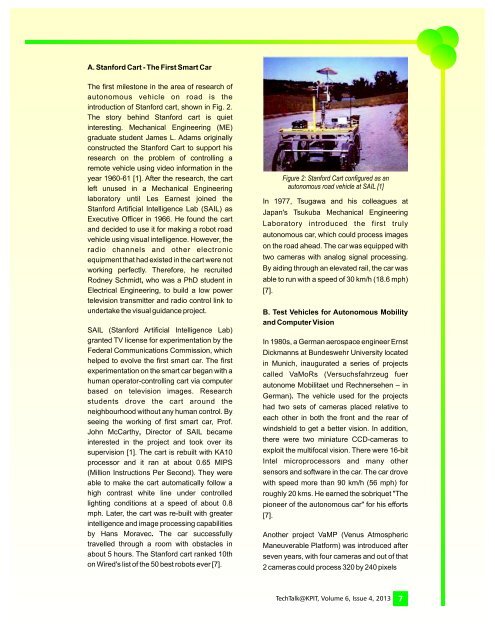Autonomous Vehicles - KPIT
Autonomous Vehicles - KPIT
Autonomous Vehicles - KPIT
Create successful ePaper yourself
Turn your PDF publications into a flip-book with our unique Google optimized e-Paper software.
A. Stanford Cart - The First Smart Car<br />
The first milestone in the area of research of<br />
autonomous vehicle on road is the<br />
introduction of Stanford cart, shown in Fig. 2.<br />
The story behind Stanford cart is quiet<br />
interesting. Mechanical Engineering (ME)<br />
graduate student James L. Adams originally<br />
constructed the Stanford Cart to support his<br />
research on the problem of controlling a<br />
remote vehicle using video information in the<br />
year 1960-61 [1]. After the research, the cart<br />
left unused in a Mechanical Engineering<br />
laboratory until Les Earnest joined the<br />
Stanford Artificial Intelligence Lab (SAIL) as<br />
Executive Officer in 1966. He found the cart<br />
and decided to use it for making a robot road<br />
vehicle using visual intelligence. However, the<br />
radio channels and other electronic<br />
equipment that had existed in the cart were not<br />
working perfectly. Therefore, he recruited<br />
Rodney Schmidt, who was a PhD student in<br />
Electrical Engineering, to build a low power<br />
television transmitter and radio control link to<br />
undertake the visual guidance project.<br />
SAIL (Stanford Artificial Intelligence Lab)<br />
granted TV license for experimentation by the<br />
Federal Communications Commission, which<br />
helped to evolve the first smart car. The first<br />
experimentation on the smart car began with a<br />
human operator-controlling cart via computer<br />
based on television images. Research<br />
students drove the cart around the<br />
neighbourhood without any human control. By<br />
seeing the working of first smart car, Prof.<br />
John McCarthy, Director of SAIL became<br />
interested in the project and took over its<br />
supervision [1]. The cart is rebuilt with KA10<br />
processor and it ran at about 0.65 MIPS<br />
(Million Instructions Per Second). They were<br />
able to make the cart automatically follow a<br />
high contrast white line under controlled<br />
lighting conditions at a speed of about 0.8<br />
mph. Later, the cart was re-built with greater<br />
intelligence and image processing capabilities<br />
by Hans Moravec. The car successfully<br />
travelled through a room with obstacles in<br />
about 5 hours. The Stanford cart ranked 10th<br />
on Wired's list of the 50 best robots ever [7].<br />
Figure 2: Stanford Cart configured as an<br />
autonomous road vehicle at SAIL [1]<br />
In 1977, Tsugawa and his colleagues at<br />
Japan's Tsukuba Mechanical Engineering<br />
Laboratory introduced the first truly<br />
autonomous car, which could process images<br />
on the road ahead. The car was equipped with<br />
two cameras with analog signal processing.<br />
By aiding through an elevated rail, the car was<br />
able to run with a speed of 30 km/h (18.6 mph)<br />
[7].<br />
B. Test <strong>Vehicles</strong> for <strong>Autonomous</strong> Mobility<br />
and Computer Vision<br />
In 1980s, a German aerospace engineer Ernst<br />
Dickmanns at Bundeswehr University located<br />
in Munich, inaugurated a series of projects<br />
called VaMoRs (Versuchsfahrzeug fuer<br />
autonome Mobilitaet und Rechnersehen – in<br />
German). The vehicle used for the projects<br />
had two sets of cameras placed relative to<br />
each other in both the front and the rear of<br />
windshield to get a better vision. In addition,<br />
there were two miniature CCD-cameras to<br />
exploit the multifocal vision. There were 16-bit<br />
Intel microprocessors and many other<br />
sensors and software in the car. The car drove<br />
with speed more than 90 km/h (56 mph) for<br />
roughly 20 kms. He earned the sobriquet "The<br />
pioneer of the autonomous car" for his efforts<br />
[7].<br />
Another project VaMP (Venus Atmospheric<br />
Maneuverable Platform) was introduced after<br />
seven years, with four cameras and out of that<br />
2 cameras could process 320 by 240 pixels<br />
TechTalk@<strong>KPIT</strong>, Volume 6, Issue 4, 2013<br />
57


